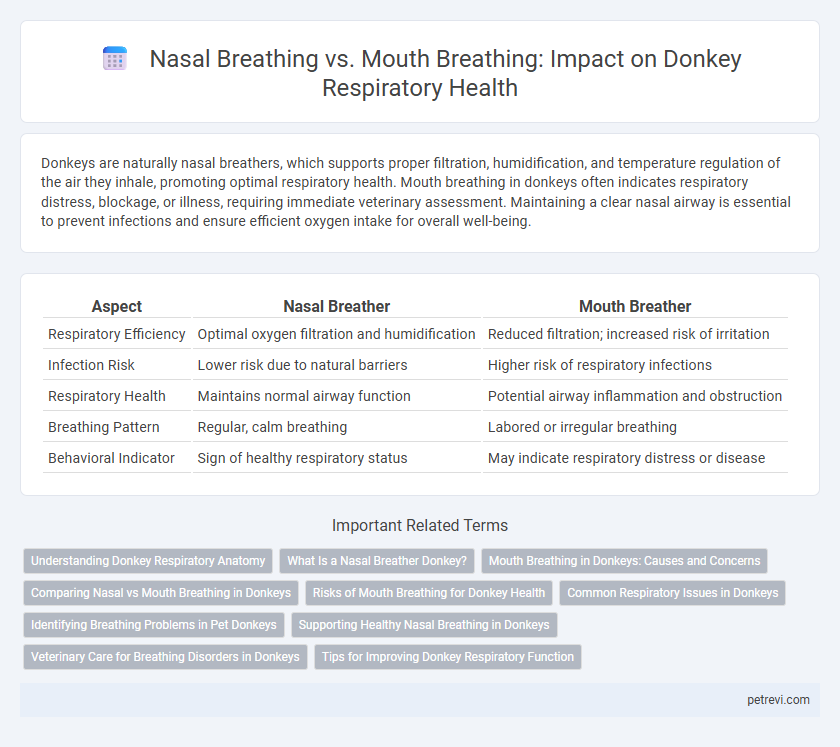Donkeys are naturally nasal breathers, which supports proper filtration, humidification, and temperature regulation of the air they inhale, promoting optimal respiratory health. Mouth breathing in donkeys often indicates respiratory distress, blockage, or illness, requiring immediate veterinary assessment. Maintaining a clear nasal airway is essential to prevent infections and ensure efficient oxygen intake for overall well-being.
Table of Comparison
| Aspect | Nasal Breather | Mouth Breather |
|---|---|---|
| Respiratory Efficiency | Optimal oxygen filtration and humidification | Reduced filtration; increased risk of irritation |
| Infection Risk | Lower risk due to natural barriers | Higher risk of respiratory infections |
| Respiratory Health | Maintains normal airway function | Potential airway inflammation and obstruction |
| Breathing Pattern | Regular, calm breathing | Labored or irregular breathing |
| Behavioral Indicator | Sign of healthy respiratory status | May indicate respiratory distress or disease |
Understanding Donkey Respiratory Anatomy
Donkeys are obligate nasal breathers, meaning their respiratory anatomy is specifically adapted for air intake through the nostrils rather than the mouth. The structure of their nasal passages, including narrow nasal cavities and a well-developed soft palate, supports efficient airflow and filtration, which is critical for maintaining respiratory health. Mouth breathing in donkeys often indicates respiratory distress or obstruction, underscoring the importance of normal nasal respiration for proper oxygen exchange and preventing respiratory infections.
What Is a Nasal Breather Donkey?
A nasal breather donkey primarily inhales and exhales through its nostrils, which is essential for optimal respiratory health and efficient oxygen exchange. This breathing method helps filter, warm, and humidify the air before it reaches the lungs, reducing the risk of respiratory infections and irritation. Nasal breathing also supports better endurance and overall wellness in donkeys compared to mouth breathing, which can increase vulnerability to respiratory issues.
Mouth Breathing in Donkeys: Causes and Concerns
Mouth breathing in donkeys often indicates underlying respiratory issues, such as nasal obstruction or chronic inflammation, that impede normal nasal airflow. Prolonged mouth breathing can lead to increased risk of respiratory infections, dehydration, and compromised oxygen exchange, negatively impacting the donkey's overall respiratory health. Identifying the root causes, including dental problems or allergic reactions, is critical for timely veterinary intervention and improving respiratory function.
Comparing Nasal vs Mouth Breathing in Donkeys
Nasal breathing in donkeys promotes optimal respiratory health by filtering, humidifying, and regulating airflow, minimizing the risk of infections and airway irritation. Mouth breathing bypasses these natural defenses, often leading to increased susceptibility to respiratory problems and reduced oxygen efficiency. Monitoring breathing patterns in donkeys aids in early detection of respiratory distress and supports better management of their overall health.
Risks of Mouth Breathing for Donkey Health
Mouth breathing in donkeys increases the risk of respiratory infections due to the bypassing of nasal filtration mechanisms that typically trap dust, allergens, and pathogens. This compromised airway defense can lead to chronic inflammation, reduced oxygen exchange, and heightened susceptibility to respiratory diseases such as equine asthma and bacterial bronchitis. Maintaining nasal breathing is crucial for preserving optimal respiratory health and preventing long-term pulmonary complications in donkeys.
Common Respiratory Issues in Donkeys
Nasal breathing in donkeys is essential for maintaining optimal respiratory health, as it filters, warms, and humidifies incoming air, reducing the risk of infections and irritations. Mouth breathing often indicates underlying respiratory issues such as chronic obstructive pulmonary disease (COPD) or upper airway obstructions, which can lead to decreased oxygen intake and increased fatigue. Recognizing these signs early is critical for managing common donkey ailments like sinusitis and respiratory infections, ensuring better overall health and performance.
Identifying Breathing Problems in Pet Donkeys
Identifying breathing problems in pet donkeys involves observing whether they are nasal breathers or mouth breathers, as healthy donkeys should primarily breathe through their nostrils. Mouth breathing in donkeys can indicate respiratory distress, infections, or obstructions such as nasal polyps or sinusitis. Early detection of abnormal breathing patterns, including labored or noisy nasal breathing, helps prevent serious respiratory diseases and ensures timely veterinary intervention.
Supporting Healthy Nasal Breathing in Donkeys
Donkeys are obligate nasal breathers, meaning nasal breathing is essential for their respiratory efficiency and overall health. Supporting healthy nasal breathing in donkeys involves maintaining clear nasal passages through regular cleaning and monitoring for signs of congestion or infection. Proper stable ventilation, controlling dust, and timely veterinary care can help prevent respiratory diseases linked to mouth breathing.
Veterinary Care for Breathing Disorders in Donkeys
Nasal breathing in donkeys ensures optimal oxygen intake and reduces the risk of respiratory infections, while mouth breathing often indicates underlying airway obstructions or health issues requiring veterinary intervention. Veterinary care for donkeys with breathing disorders includes thorough examinations, endoscopic evaluations, and targeted treatments such as anti-inflammatory medications or surgical correction to restore normal nasal airflow. Early diagnosis and management of breathing irregularities significantly improve respiratory health and overall wellbeing in donkeys.
Tips for Improving Donkey Respiratory Function
Nasal breathing in donkeys supports optimal respiratory function by filtering air and maintaining moisture, reducing the risk of infections commonly linked to mouth breathing. Ensuring a dust-free, well-ventilated environment and providing regular airway clearance through gentle exercise can enhance nasal airflow and overall respiratory health. Regular veterinary check-ups and observing for signs of nasal discharge or labored breathing help identify issues early, promoting timely intervention and improved respiratory function.
Nasal Breather vs Mouth Breather for Donkey Respiratory Health Infographic

 petrevi.com
petrevi.com